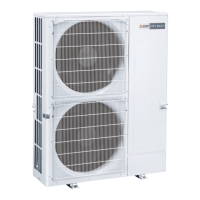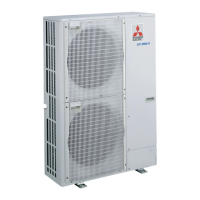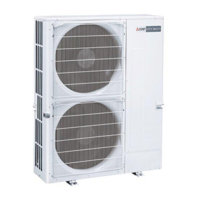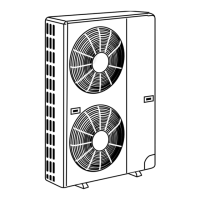8
4. Installing the refrigerant piping
4.3. Connecting pipes (Fig. 4-2) (Fig. 4-3)
• Conductsufcientanti-condensationandinsulationworktopreventwaterdrip-
ping from the refrigerant piping. (liquid pipe/gas pipe)
• Increaseinsulationdependingontheenvironmentwheretherefrigerantpipingis
installed, or condensation may occur on the surface of the insulation material.
(Insulation material Heat-resistant temperature: 120 °C, 248 °F, Thickness:
15 mm, 5/8 inch or more)
* When the refrigerant piping is used in locations subject to high tempera-
ture and humidity such as in the attic, further addition of insulation may be
required.
• Toinsulatetherefrigerantpiping,applyheat-resistantpolyethylenefoambetween
the indoor unit and insulation material as well as to the net between the insulation
materialllingallgaps.
(Condensation forming on the piping may result in condensation in the room or
burns when contacting the piping.)
• Theindoorpartsofthedrainpipeshouldbewrappedwithpolyethylenefoaminsu-
lationmaterials(specicgravityof0.03,thicknessof9mm(3/8inch)ormore).
[Fig. 4-3]
• Applythinlayerofrefrigerantoiltopipeandjointseatingsurfacebeforetightening
arenut. A
• Use2wrenchestotightenpipingconnections.B
• Use leak detector or soapy water tocheck for gasleaks after connectionsare
completed.
• Applyrefrigeratingmachineoilovertheentireareseatsurface.C
• Usethearenutsasfollows.D
• Whenbendingthepipes,becarefulnottobreakthem.Bendradiusof100mm
(4inch)to150mm(6inch)aresufcient.
• Makesurethepipesdonotcontactthecompressor.Abnormalnoiseorvibration
may result.
1 Pipes must be connected starting from the indoor unit.
Flare nuts must be tightened with a torque wrench.
2 Flare the liquid pipes and gas pipes and apply a thin layer of refrigeration oil (Ap-
plied on site).
• Whenusualpipesealingisused,refertoTable2foraringofR410Arefrigerant
pipes.
ThesizeadjustmentgaugecanbeusedtoconrmAmeasurements.
Warning:
When installing the unit, securely connect the refrigerant pipes before starting
the compressor.
Caution:
• Be sure to wrap insulation around the piping. Direct contact with the bare
piping may result in burns or frostbite.
Table 2 (Fig. 4-4) mm (inch)
Copper pipe O.D.
A
Flare tool for R410A Flare tool for R22·R407C
Clutch type
ø6.35(1/4) 0 - 0.5 (0 - 1/64) 1.0 - 1.5 (3/64 - 1/16)
ø9.52(3/8) 0 - 0.5 (0 - 1/64) 1.0 - 1.5 (3/64 - 1/16)
ø12.7(1/2) 0 - 0.5 (0 - 1/64) 1.0 - 1.5 (3/64 - 1/16)
ø15.88(5/8) 0 - 0.5 (0 - 1/64) 1.0 - 1.5 (3/64 - 1/16)
A (Fig. 4-3)
Copper pipe O.D.
(mm) (inch)
Flare dimensions
øAdimensions(mm)(inch)
ø6.35(1/4) 8.7 - 9.1 (5/16 - 3/8)
ø9.52(3/8) 12.8 - 13.2 (1/2 - 33/64)
ø12.7(1/2) 16.2 - 16.6 (41/64 - 21/32)
ø15.88(5/8) 19.3 - 19.7 (49/64 - 25/32)
Copper pipe O.D.
(mm) (inch)
Flare nut O.D.
(mm) (inch)
Tightening torque
(N·m)*(ft·lbs)
ø6.35(1/4) 17 (43/64) 14 - 18 (10 - 13)
ø6.35(1/4) 22 (7/8) 34 - 42 (25 - 30)
ø9.52(3/8) 22 (7/8) 34 - 42 (25 - 30)
ø9.52(3/8) 26 (1-3/64) 49 - 61 (35 - 44)
ø12.7(1/2) 26 (1-3/64) 49 - 61 (35 - 44)
ø12.7(1/2) 29 (1-9/64) 68 - 82 (49 - 59)
ø15.88(5/8) 29 (1-9/64) 68 - 82 (49 - 59)
ø15.88(5/8) 36 (1-27/64) 100 - 120 (71 - 87)
*1N·m
10 kgf·cm
A
B
C
D
A Liquid pipe
B Gas pipe
C Insulation
D Taping
Fig. 4-2
Fig. 4-3
A Flare cutting dimensions
B Flare nut tightening torque
90° ± 0.5°
R1/64" to R1/32"
ø
A
45°± 2°
Fig. 4-4
A Die
B Copper pipe
A
RG79F079H01_EN.indd 8 2/24/2016 2:57:20 PM

